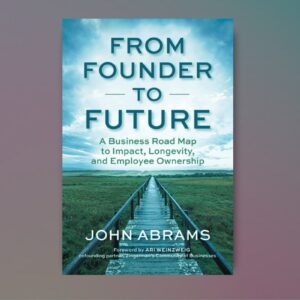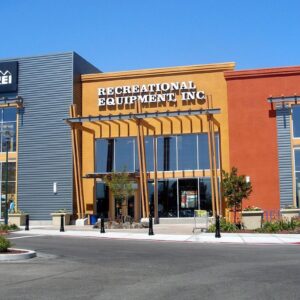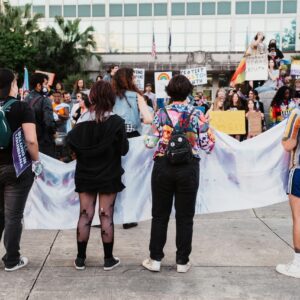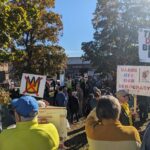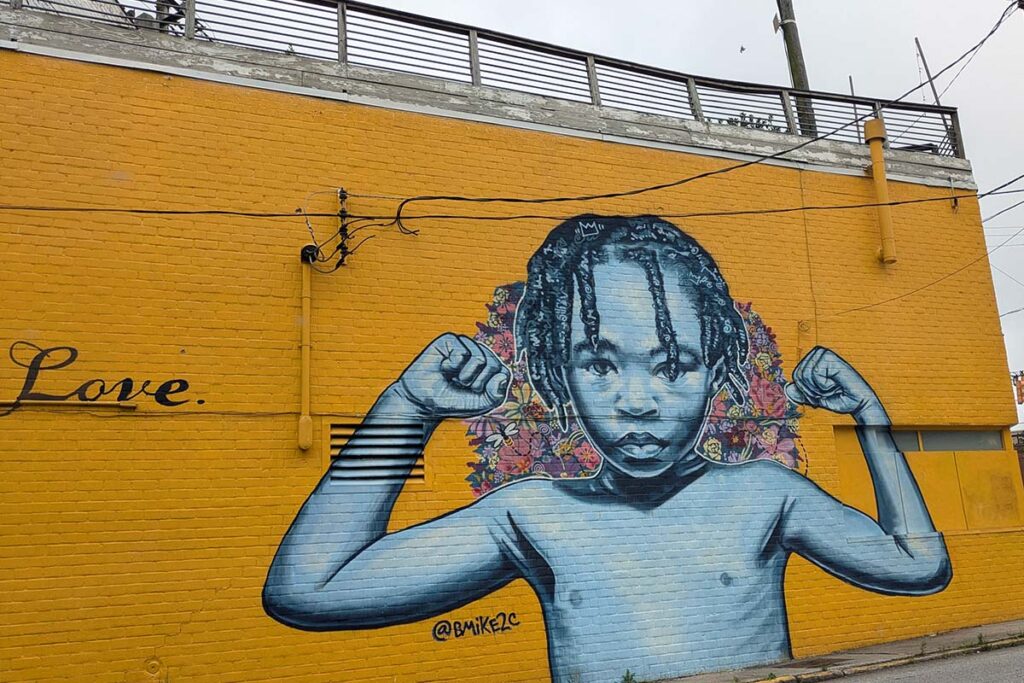
In anthropology, edges are spaces of power and danger, between what is and what could be. As Tressie McMillan Cottom stated on a recent podcast, “One of the most powerful analytical positions a person can be in is to be in something and not of it. You are both inside and outside at the same time…to see it, not be of it—so you’re not beholden to upholding it.”
We believe in the power of self-determination, community ownership, and democratized capital to regenerate the soils of emerging economies once laid barren by capitalism.
Below we offer a set of “postcards” from some of our journeys. Taken together, the fractals of our experiences offer, we believe, glimpses of a transformation vision, rooted in a solidarity economy.
Postcard 1: In Dialogue with Du Bois (Johan)
Recently, I visited Great Barrington, MA, birthplace of the great W.E.B. Du Bois and while attempting to take an alleyway shortcut, I stumbled upon a colorful mural honoring his legacy.

I was somewhat familiar with his work. I knew he was an advocate for cooperatives and Pan-Africanism, but I had not read much of it. I became curious about what Du Bois would have to say regarding this strange moment we’re in. I came across an article he penned in 1925 called “Worlds of Color” in which he revisited his claim that “the problem of the Twentieth Century is the problem of the color line” and added that the present “Problem of Problems” was “Labor.”
I was struck by his nuanced understanding of racial dynamics and global economics. This was written 100 years ago, yet it seems eerily relevant to our world today. Was he correct? At the time, US unemployment was around 3.2 percent. Yet, considering he was one presidential term away from the Great Depression, which would see unemployment rise to 25 percent, he was surprisingly prescient.
The New Deal, our government’s response to the Great Depression, was, by many measures, an economic revolution. It employed millions through programs such as the Civilian Conservation Corps (CCC) and the Works Progress Administration (WPA), leaving a lasting legacy on social welfare programs and government intervention in economic affairs all while reinforcing and exacerbating existing racial inequalities, especially through redlining.
If I were in dialogue with Du Bois today, I would ask: If labor was the problem of the 20th century, what then is the problem of the 21st century?
Postcard 2: An Experiment in Economic Democracy (Carolyn)
“Can capital democratize our economy?” In 1974, George Pillsbury and other young beneficiaries of industry who founded the Haymarket People’s Fund thought so. Long before “trust-based philanthropy,” Pillsbury sought to democratize finance. Later, seeing New Englanders respond to food-system industrialization by forming buying clubs, he launched a $25,000 revolving fund for start-up food cooperatives.
Our workplace, the Cooperative Fund of the Northeast (CFNE), emerged from that seed fund. As a community development financial institution (CDFI), we pool individual social investments to support consumer, producer, and worker cooperatives. Unlike most CDFIs which depend heavily on banks and government programs for loan capital, 64 percent of our portfolio comes from individual investors and family trusts.
As we’ve grown from a grassroots startup into an anchor of the cooperative economy, CFNE faces a challenge familiar to incumbent institutions: How do we remain a force for justice and democracy in a rapidly changing world?
Postcard 3: Imagining a Black Solidarity Economy (Johan)
What does it take to lay the groundwork for a Black solidarity economy?

This year, in pursuit of an answer to this question, I traveled to Atlanta, GA, to attend the National Conference on the Black Cooperative Agenda. While previous years featured panels and presentations, this year’s conference was designed as a “Black Solidarity Movement Assembly,” for Black co-op leaders to help determine the role of the reemerging Black co-op ecosystem.
Over three days, participants gathered to begin laying the groundwork for a new economy—one that authentically included them and felt like home. Together, we envisioned liberated realities, reflected on the values we would need to embody to realize our collective vision and deliberated on how we would build intergenerational power to sustain movement leadership over time.
It was a powerful experience—one that taught me an important lesson about defiance. When we cultivate a Black solidarity economy, we do so in direct defiance to patterns of dominance and exclusion in our society. This isn’t simply an external practice, it must be practiced within the homegrown institutions that people in the movement create to respond to our most intimate issues of livelihood and liberation.
Postcard 4: Tending an Urban Oasis (Carolyn)
At my family home, our “garden” began with just a few tubs of veggies on the driveway.

Now, 18 years later, a little ecosystem has regenerated along with the soil: Bees show up to enjoy the hyssop. Monarch butterflies come in with the milkweed. And every July, goldfinches feast on the seeds of the eight-foot-tall sunflowers. These plants and pollinators show up in the disturbed edges of our inhospitable urban oasis. They thrive because of each other, not in spite of one another—cooling the air, pollinating our apples and okra, bringing color and life to an unfavored neighborhood.
This urban ecosystem persists because previous generations of plants broke ground, cast seeds, and left no waste behind, only food. Black, Indigenous, and immigrant communities know how to live this as well. We spread our humble seeds and restore the soils where we find ourselves, recreating shared abundance a season at a time.
In CFNE’s Learning team, we take a similar approach. We lean into the edges of our ecosystem and work with what’s already growing. Creators build vendor-owned pop-up markets. Seniors purchase the land under their manufactured homes. Doulas organize shared service cooperatives to bill insurance. These aren’t side hustles. They are practices of edge-dwellers—solutions born from necessity, brilliance, and self-reliance.
CDFIs were created out of a myth of doing for: that theft of Black and Indigenous labor and assets, redlining, and economic apartheid can be redressed through “financial and technical assistance.” But what if institutions learned to inhabit the edge, to read what’s growing, to recognize the seedlings of milkweed from poisonous black swallowwort?
Inhabiting the edge requires being in relationship with impacted communities and with the world of capital. It means hiring those of us who move between worlds—bicultural, migrant, queer, multiracial folks.
It also means investing in programs that invite incumbent institutions to step out onto the edge with us—placing or hosting fellows, participating in loans they might usually judge “too risky,” listening before jumping to write the next grant proposal.
Can we learn to nurture what wants to grow in the generative chaos between the incumbent and the possible, and allow ourselves to be nourished in the process?
Postcard 5: The View from Quebec (Johan)
Last July, I attended the Association for Cooperative Educators (ACE) Institute in Montreal, which was held in conjunction with the International Cooperative Alliance’s Committee on Cooperative Research’s global conference.
There, I caught a glimmer of the future we’re fighting for.
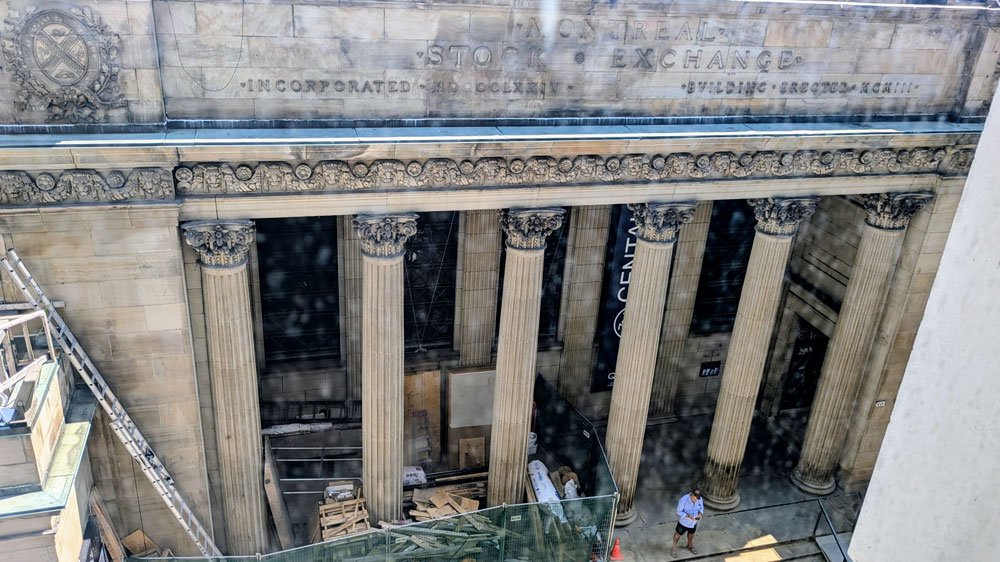
In my five days in Montreal, I witnessed the impressive efforts of young people working to transform their city in every sector from food sovereignty to urban design. I visited the “largest urban agriculture cooperative in the world,” la Centrale Agricole, located in the heart of Montreal.
This unique cooperative brings together over 20 forward-thinking companies and organizations committed to building a sustainable, circular, and socially responsible food system and engaging 117 emerging entrepreneurs and employees.
I visited places like Le Comité, a worker-owned design firm exploring how urban design can drive social change and reclaim public space while engaging design students to create transformative and eye-catching projects throughout the city.
At the conference, I also observed speeches and panels from world leaders remarking on the apparent fact that “solidarity exists within the global capitalist environment.” Others were more inclined to revolution. Inspired by Chilean solidarity economy theorist Luis Razeto Migliaro, they remarked, “You don’t need capital to start a co-op.”
I listened to the experiences of cooperators who were fighting to decolonize their organizations, to shift their enterprises away from extraction and exploitation while experiencing tremendous tensions around pay equity and the sustainability of their businesses. Conference attendees reflected on how decolonizing the inner workings of the enterprise alone doesn’t change the colonized context that the money they’re competing for comes from.
And where did the money come from?
As I stood before the crumbling edifice of capitalism, the Montreal Stock Exchange building featured in the photo above, it signified something I’ve accepted for some time now: The old world is crumbling.
But my time in Montreal also challenged an observation I had taken for granted that the new world is shaky.
Previously, I had sensed how difficult it would be to develop the supportive systems and capital flows that could simultaneously raze the rigid but crumbling infrastructure of White supremacist capitalism while elevating the unsteady but promising seedlings of a solidarity economy that is decolonized and socially innovative.
At this conference, I saw firsthand what conditions are needed to give life to these emerging perspectives and economies. I saw young people eager to expand on top of what exists today and build beyond. Too many co-op members I know have come to doubt co-ops’ transformative potential, but the young attendees were showing us that perhaps the future is cooperative, after all.

A Final Postcard: Revolutionary Visions
We are on the edge of an economic revolution.
We’re living through a time of layered liminality—multiple overlapping transitions that are at once economic, political, cultural, and demographic. And with our economy, institutions, trade agreements, and global alliances being undermined from within, the revolution might not require bulldozers.
A revolutionary response requires rituals and structures to keep us safe as we navigate these rifts. It requires weavers, connectors, builders of a new world—one that is more flexible, sustainable, and human-centered than the rigid edifices of colonialism and racialized capitalism.
At conferences on community investment and economic development, speakers struggle to articulate how incumbent institutions will respond. Yet Black, Indigenous, immigrant, and low-income communities that are used to living on the edge know that true solutions lie in mutualism, solidarity, and trusting relationships, rather than program grants or arbitrary and undersized infusions of concessionary capital.
In his 2020 manual How to Create a Solidarity Enterprise, Migliaro described the “C factor,” the productive economic force generated when people unite for a shared goal. He posits that no solidarity enterprise can persist without this foundation of shared care, ethical values, and will among its members, while the C factor can account for up to half of productivity in an effective organization.
Migliaro began his guide to solidarity enterprise development with the claim, “You don’t need capital to start a solidarity enterprise.” And in fact, financing does not come up until three-quarters of the way through the book.
Only after a group has developed a business plan, assessed all the factors that members and their networks can provide and gotten member commitments of contributions, should they begin to consider internal or external financing.
With the C factor in mind, solidarity enterprises, including cooperatives, may be the practice through which groups of people can harness what they and their communities freely offer, transforming it into tangible, mutually beneficial solutions. Catalyzing these homegrown solutions is one way that institutions and investors can lean into and learn from the edge.
In her book The Social Justice Investor, Andrea Longton noted that 63 percent of investors seek impact, but 50 percent are unsure where to find it.
Those of us occupying the edge spaces between institutions and communities can bridge this gap by mobilizing investors, capital providers and local leaders—informed by the solidarity economy—for the return of the pendulum. Our interaction and intimacy with both worlds—the incumbent and the emergent—is what will enable us to coevolve and envision revolutionary investments of capital and care in the “Worlds of Color” that remain disinvested, disconnected and underserved by our financial institutions to this day, 100 years after Du Bois.

